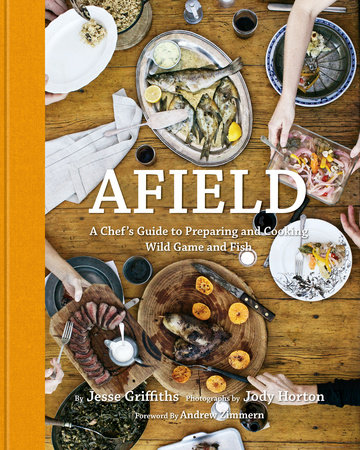Foreword -
Andrew Zimmern
Introduction by
Jesse Griffiths
--
Foreword -
Andrew Zimmern
For thousands of years a man was measured in simple terms. Honor and hard work gave him the respect of his peers and status in his community. Over the last century, we have seen that change. Impermanence of lifestyles, class privilege determined solely on wealth, the cultish narcissism of the age of celebrity, and the diminished returns on achievement—these societal woes have all contributed to a cultural standard that our grandparents, who knew that the reward was in the doing, wouldn’t recognize. Good or bad, it’s a fact. In an age where the world is changing so quickly, in our disposable culture, the ability to pause and put some space between what we think we want and what we decide to do is one of our greatest necessities. Which is why I sought out Jesse Griffiths one day a few years back on a trip to Austin, Texas.
Here was a man living a life that is supremely of the moment, his professional code of conduct couldn’t be more fitting with everything that is right about food in America. And more importantly his “way of doing” provides thought leadership and actionable pursuits.
Instinctively we realize that we live in an age where we no longer just want to see recipes with bacon in it, we want to know how to cure the bacon ourselves. So here was a chef who not only was providing us with those answers, he was educating us about lifestyle choices that go beyond the gold standard.
Jesse leads by example. We can talk all we want about sustainability, traditional food arts, great cooking, locally sourced foods, and every other neutered catch phrase of the modern food world, but we need heroes who are willing to show us by doing, not by talking. Jesse is that kind of guy, and trust me they are rare and precious. He is a tireless worker, who hunts and fishes, appreciates our great outdoors, understands the importance of what we need to preserve in our cultural heritage, and translates it for the modern age—is there anything more important? That he chooses to do it in the food space is just the icing on the cake for someone like me.
Nothing is more important, or timely, in the search for a solution to the breakdown to our global systemic food system than the thorough study, reimagining, and ongoing education of Americans on the subject of hunting, fishing, and cooking as an inseparable triptych. If some of our modernist ideas are failing, if production and mechanization compromise our health and well being, if you are curious at all about pursuing solutions instead of tilting at windmills, then you will want to understand fully a food system that is economically, culturally, and environmentally sustainable. Jesse understands at a grassroots level what it takes to live truthfully, in a meaningful way that is deeply felt and personal. He doesn’t speak in sound bites or create lifestyle choices with a publicist. He lives and works in accordance with his own principles and that is what I admire about him the most. The benefit we all have is that we can learn from inspiring leaders like Jesse, and act locally while thinking globally. For me the appeal of his book is that it is approachable and engaging for us all.
For those committed to big ideas, or simply for a way to have more fun in the field and in the kitchen, this is a must read. The outdoors-person’s approach to food has worked…does work…and will always work, and within its ideology are practical ways that anyone interested in changing their world one delicious plate at a time will want to learn about. Slowing down the food systems we sped up, solving our food-health issues, and preserving the best practices of our lost generations are all attainable by living the hunting-cooking lifestyle.
At the end of the day, this is an inspiring collection of stories from the field, replete with 85 recipes that are as delicious as they are fascinating to page through. Anyone who loves food will enjoy this book. The magic, and why I think Afield is a special work, is that it fully portrays a way of living and thinking that allows us to return to a more simple way to be measured and respected. And it does so without lecturing or pandering. It reminds me that by living a more principled life, I can make my world a better place and I can use food and cooking to do it. This book is a beautiful piece of work, and after you read it, and cook from it, please get outside and get dirty with it. Wherever you are, the great outdoors is waiting for you, afield.
---
Introduction by
Jesse Griffiths I once described hunting to my antihunting mother as the same as planting, growing, and harvesting a carrot, just compressed into a few exciting moments. There is the preparation, the commitment, the anticipation, and the payoff—the sad and final moment when the food comes to hand, dead or soon-to-be. A carrot’s journey between seed and plate takes about four months, give or take. The span of time between a stick bobber disappearing into a murky creek and a fat crappie flopping onto the bank, or a mourning dove being hit and spiraling down into mesquite thicket is about ten seconds, give or take.
In hunting and fishing, the moment the animal is brought to hand is not the end, but rather the middle of the story. There is still much more work to be done— scaling, skinning, packaging, braising, frying—and the final result is far more rewarding. A gorgeous justcaught fall pompano, gutted and rubbed with olive oil, or a tray full of fresh sausages are the real reasons we spend time afield.
I grew up fishing with my father and only came to hunting in the last few years, which has doubled the time I spend outdoors and pretty much keeps me helplessly distracted year-round. Under the tutelage of many generous people, I have been able to forge a relationship between fish and game and my passion for cooking. This book is not written from the perspective of an expert hunter or fisherman, but from an obsessed one who spends a lot of time preparing and sharing what he catches. Some of the best times I’ve ever had were with friends on the bank of a river, drinking a little beer and frying up that evening’s batch of redbreast sunfish. Or maybe sautéing a fresh venison liver with some bacon and onions after a long, cold day in the woods, knowing that we will have good, ostensibly organic, free-range, grass-fed meat in our freezer for the rest of the year.
Over the past few generations, we’ve collectively lost the skills that our ancestors possessed to live off the land. Perhaps this is because the need is no longer there, with the proliferation and ubiquity of mass-produced food. Game meats and fresh fish are truly the healthiest proteins you can get your hands on, and, yes, they do taste different than farmed animals. This is because they’ve fed on wild grasses or minnows or croton seeds, and reflect the beautiful and austere surroundings from which they were gathered. In many cultures, this is perceived as an advantage—a boon to the lucky eater.
This book means not only to explore the world of direct sourcing—that is, being wholly involved in sustaining oneself —but to enlighten and encourage more responsibility and thrift in preparing, cooking, and sharing food from the wild. Hunting and fishing for your dinner gives you a distinct sense of ownership and connection to your own food sources—as well as the responsibilities that come with that, like stewardship, conservation, and a deep respect for life and death.
I don’t remember exactly how this project started. I was easily enamored with Jody’s photography, and I love the outdoors. I also work round the clock at my job as a chef and wanted to find a way to incorporate hunting and fishing into my daily life somehow. The solution seemed obvious: instruct people to cook what they hunt and fish for, and include good pictures.
Jody is also a hunter and fisherman, but he favors his camera more. He never really puts it down to cast a rod for more than a couple of minutes, and he did once annoyingly take six shots at some doves, dropping four, before casually resuming his photography while I went to collect and pluck his downed birds.
This book allowed us to spend time with our peers and friends who are as attuned to eating well as we are. They are fellow chefs, guides, writers, architects, ranchers, farmers, nurses, teachers, carpenters, lawyers, and, of course, Tink—who defies categorization. Every anecdote shared in the pages that follow is real. Every animal shot or caught was happily eaten and, be assured that we were having a seriously good time throughout.
These stories take place in the Great State of Texas, specifically the Central Texas Hill Country around Austin, where we are blessed with clear-flowing limestone streams, muddy prairie lakes, and pine forests within a couple of hours drive in any direction. Add a couple more hours to that and you have saltwater bays and surf, semi-arid plains, and impenetrable South Texas thickets, teeming with deer, javelinas (peccaries), and huge boars. It is truly a beautiful and bountiful place, but the information contained in Afield is germane to any place game or fish are found. We emphatically encourage experimentation and substitution with these recipes depending on the geography and seasons.
What are seasons, really? When hunting, fishing, farming, or foraging, one is, by default, confined to eating seasonally. Just as there’s a right and wrong time of year to grow and pick different types of produce, the same is true for wild fish and game. Ducks arrive (here) en masse in late winter; the crappie spawn when the wildflowers pop in the spring and the sunfish will bed up around the first full moon of May or June. Don’t ever shoot a rabbit in the summer, unless you want to see some parasites. These natural parameters present a preordained guide to eating what is available throughout the year. This sequence of beginnings and endings wrapped up in a year provides constant opportunity, in perpetuity.
The recipes, or rather the cooking techniques, in this book are based not only on the availability— legal and literal—of fish and game, but of the things that grow around them. This newfangled ideal, practiced since the dawn of time, not only makes sense, but is inherently frugal, pleasantly self-reliant, and it tastes better. As a regimen, place-oriented eating was the norm for every generation up until that of our greatgrandparents. Nowadays, you may commonly hear of this style of eating, or food grown without chemicals and in the proper season as “organic”, as being expensive or elitist compared to “conventional” meats and produce. However, food planted with the seasons, hunted in season, and gathered in season was once simply known as good food.
With so much time, effort, and resources spent on acquiring our own game, it seems incumbent upon us to spend some energy honoring the animal when we eat it. The pork added to sausage to increase its fat content should be good pork, raised happily outside, just like deer; otherwise it’s like diluting a dusty, twenty-yearold bottle of Châteauneuf-du-pape with convenience store swill. That venison from the doe you shot that’s going in that sausage is some of the best meat available anywhere and deserves good company. Good garlic, good salt, good spices, good pig.
The vegetables and fruit that cosmically appear throughout the seasons should likewise be of high quality. If it were up to me, there would be an opening day for strawberries, too, because they just aren’t right until they’re ready. Sure, you can stretch it out, buying strawberries whenever you want them, but they don’t want to be eaten until they’re red and ripe and sweet and from someplace nearby. A very religious and conservative farmer friend once told me regarding food, “You can’t always get what you want, but you get what you need.” Mr. Alexander’s simple tenet of good eating was remarkably enlightening: our food surrounds us, just don’t take too much. I also would have never pegged him for a Stones fan.
Treated in this way, food becomes much, much easier to make, not harder. I promise you that. When you hunt, fish, and harvest or buy your ingredients locally, the decisions have already been made for you. Recipes become methods and concepts instead of rote standards. Your shopping list is literally handed to you by your surroundings. And all that’s left for you to do is to decide how you want to heat them up.
Copyright © 2012 by Jesse Griffiths & Jody Horton. All rights reserved. No part of this excerpt may be reproduced or reprinted without permission in writing from the publisher.







